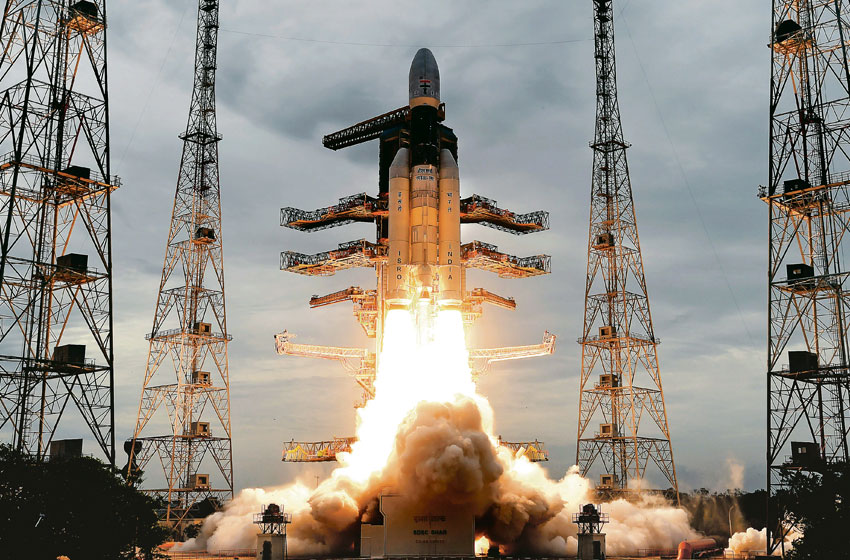India’s Chandrayaan Mission: A giant leap for the nation and Beyond

India, the land of diversity and innovation, has once again captured the world’s attention with its remarkable achievement in space exploration. The Chandrayaan mission, launched by the Indian Space Research Organisation (ISRO), has marked a significant milestone in India’s journey to the moon, showcasing its scientific prowess and ambition. In this article, we delve into the fascinating details of the Chandrayaan mission while exploring some fun facts that make this endeavor truly awe-inspiring.
Aiming for the Moon
Launched on July 22, 2019, from the Satish Dhawan Space Centre in Sriharikota, India’s Chandrayaan 2 mission aimed to explore the uncharted lunar south pole. Comprising an orbiter, a lander named Vikram, and a rover named Pragyan, this ambitious mission sought to extensively study the moon’s surface, composition, and the presence of water molecules.
Exploring the Lunar Surface
Chandrayaan 2’s orbiter, equipped with advanced scientific instruments, was designed to orbit the moon at an average altitude of 100 kilometers. It carried eight state-of-the-art payloads, including the Terrain Mapping Camera-2, the Imaging Infrared Spectrometer, and the Dual Frequency Synthetic Aperture Radar, to map and analyze the moon’s surface.
The lander, Vikram, weighing around 1,471 kilograms, aimed to make a soft landing near the lunar south pole. It carried three payloads, including the Instrument for Lunar Seismic Activity, Chandra’s Surface Thermo-Physical Experiment, and the Langmuir Probe, which would have provided valuable data about the moon’s surface and atmosphere.
A Rover’s Expedition
The rover, Pragyan, housed within the Vikram lander, was designed to traverse the lunar terrain, analyzing the soil composition and sending back crucial data. Weighing about 27 kilograms, Pragyan was equipped with advanced technology that allowed it to move at a speed of 1 centimeter per second, capturing high-resolution images and analyzing the moon’s surface for a planned lifespan of 14 Earth days.
Fun Facts about Chandrayaan Mission
- Women Power
Chandrayaan 2 mission was led by two prominent women scientists –
Dr. M. Vanitha, the Project Director, and
Dr. Ritu Karidhal, the Mission Director. Their leadership and technical expertise played a crucial role in the mission’s success, inspiring millions of women across the globe. - Cost-Effective Endeavor
With a budget of approximately $140 million, the Chandrayaan 2 mission stands as one of the most cost-effective space exploration programs. This remarkable achievement emphasises India’s ability to accomplish significant milestones within limited resources. It is astonishing to note that India’s Chandrayaan 2 mission, with a budget of approximately $140 million, cost less than the production budget of the Hollywood blockbuster movie “Interstellar.” This stark comparison highlights the incredible efficiency and cost-effectiveness of India’s space program, showcasing how significant scientific achievements can be accomplished even with limited resources. The Chandrayaan mission’s success further emphasises that the pursuit of knowledge and exploration can be achieved without extravagant expenses. - Heritage Site on the Moon:
As part of the mission, the Vikram lander carried a small, credit-card-sized disk containing the names of around 1.38 million people who contributed to the mission. This disk also carried the Indian flag, making it a unique symbol of national pride. - Youngest Moon Mission:
India’s Chandrayaan 2 mission holds the record for the youngest astronautical lunar mission to date. The average age of the team involved in the mission was below 35, showcasing India’s vibrant and dynamic scientific community. - Water on the Moon:
One of the primary objectives of the Chandrayaan mission was to detect the presence of water molecules on the lunar surface.This discovery would have opened up new possibilities for future human space exploration and even the establishment of a lunar base.
India’s Chandrayaan mission has undeniably left an indelible mark on the nation’s rich scientific legacy. With its remarkable achievements and inspiring leadership, this mission has set the stage for future space exploration endeavors. As India continues to reach for the skies, the Chandrayaan mission stands as a testament to the nation’s scientific prowess, creativity, and unwavering spirit of discovery.





